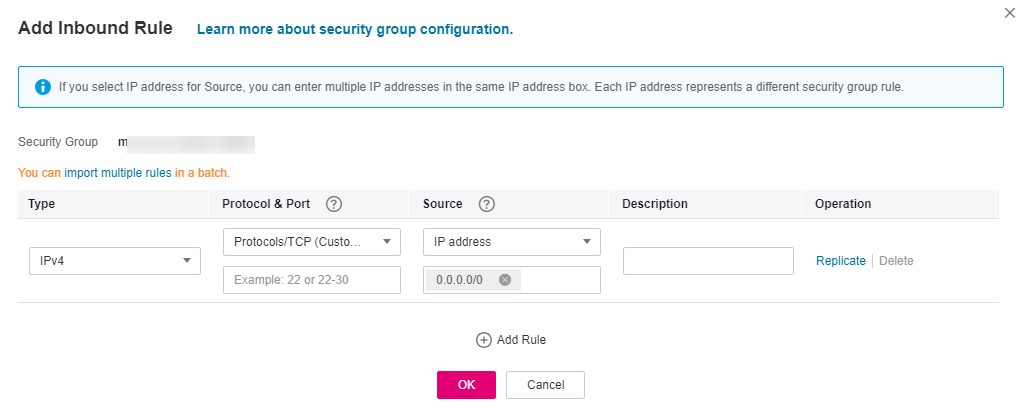Configuring Security Group Rules¶
Scenarios¶
Similar to firewall, a security group is a logical group used to control network access. You can define access rules for a security group to protect the ECSs that are added to this security group.
Inbound: Inbound rules allow external network traffic to be sent to the ECSs in the security group.
Outbound: Outbound rules allow network traffic from the ECSs in the security group to be sent out of the security group.
For details about the default security group rules, see Virtual Private Cloud User Guide. For details about configuration examples for security group rules, see Security Group Configuration Examples.
Procedure¶
Log in to the management console.
Click
 in the upper left corner and select your region and project.
in the upper left corner and select your region and project.Under Computing, click Elastic Cloud Server.
On the Elastic Cloud Server page, click the name of the target ECS.
The page providing details about the ECS is displayed.
Click the Security Groups tab, expand the information of the security group, and view security group rules.
Click the security group ID.
The system automatically switches to the security group details page.
On the Inbound Rules tab, click Add Rule.
The Add Inbound Rule dialog box is displayed.
Configure required parameters.
You can click + to add more inbound rules.

Figure 1 Adding inbound rules¶
Table 1 Inbound rule parameter description¶ Parameter
Description
Example Value
Protocol
The network protocol used to match traffic in a security group rule.
Currently, the value can be All, TCP, UDP, GRE, ICMP, or more.
TCP
Port
The port or port range over which traffic can reach your ECS. The value can be from 1 to 65535.
22, or 22-30
Type
Source IP address version. You can select:
IPv4
IPv6
IPv4
Source
Source of the security group rule. The value can be an IP address or a security group to allow access from IP addresses or instances in the security group.
IP address:
Single IP address: 192.168.10.10/32
All IP addresses: 0.0.0.0/0
IP address range: 192.168.1.0/24
Security group: The source is from another security group. You can select a security group in the same region from the drop-down list. If there is instance A in security group A and instance B in security group B, and the inbound rule of security group A allows traffic from security group B, traffic is allowed from instance B to instance A.
If the source is a security group, this rule will apply to all instances associated with the selected security group.
0.0.0.0/0
Description
Supplementary information about the security group rule. This parameter is optional.
The description can contain a maximum of 255 characters and cannot contain angle brackets (< or >).
-Click OK.
The inbound rule list is displayed.
On the Outbound Rules tab, click Add Rule.
The Add Outbound Rule dialog box is displayed.
Configure required parameters.
You can click + to add more outbound rules.

Figure 2 Adding outbound rules¶
Table 2 Outbound rule parameter description¶ Parameter
Description
Example Value
Protocol
The network protocol used to match traffic in a security group rule.
Currently, the value can be All, TCP, UDP, GRE, ICMP, or more.
TCP
Port
The port or port range over which traffic can leave your ECS. The value can be from 1 to 65535.
22, or 22-30
Type
Source IP address version. You can select:
IPv4
IPv6
IPv4
Destination
Destination of the security group rule. The value can be an IP address or a security group to allow access to IP addresses or instances in the security group.
IP address:
Single IP address: 192.168.10.10/32
All IP addresses: 0.0.0.0/0
IP address range: 192.168.1.0/24
Security group: The source is from another security group. You can select a security group in the same region from the drop-down list. If there is instance A in security group A and instance B in security group B, and the inbound rule of security group A allows traffic from security group B, traffic is allowed from instance B to instance A.
0.0.0.0/0
Description
Supplementary information about the security group rule. This parameter is optional.
The description can contain a maximum of 255 characters and cannot contain angle brackets (< or >).
-Click OK to complete the security rule configuration.